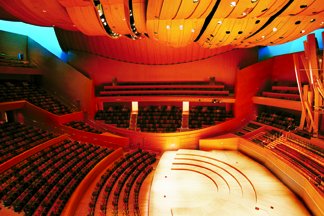S & H International Concert Review
The Green Umbrella: "Solos Night", Los Angeles Philharmonic New Music Group, Walt Disney Concert Hall, Los Angeles, California, Monday, November 3, 2003 (BH)
Van der Aa: Oog for cello and soundtrack (U.S. premiere)
Salonen: Laughing Unlearnt
Matthews: Bassoonova (world premiere)
Adès: Darknesse Visible
Hyla: Detour Ahead (world premiere)
Reich: New York Counterpoint
Who would have imagined that an evening of moderately daunting contemporary music would summon a crowd of what appeared to be some 1,200 people in the new Walt Disney Concert Hall? A cynical companion suggested that since many of the more easy-to-approach evenings were sold out, some people just wanted to see the inside of the building. (No doubt this is true.) But if the audience were composed primarily of just the curious, then the curious were a remarkably well-behaved and attentive bunch during a concert that was perhaps not the easiest for new music novices to assimilate.
So kudos to Steven Stucky, consulting composer for this series, for programming this daring line-up during the hallís first few days, featuring some of the Los Angeles Philharmonicís outstanding principal players in repertoire they probably donít get to perform that often. This intimate affair also contrasted beautifully with the Mahler storm that rocked the space over the weekend.
I confess that only one work really grabbed me by the shirt collar: the opening Oog, by Dutch composer Michel van der Aa, given a smashing performance by Peter Stumpf. With the cello "in an almost masochistic fight with the tape," Stumpf piled on many extended techniques (e.g., thumping the base of the instrument) to produce a completely engaging dialogue with the electronic soundtrack. And as in the Reich at the end of the evening, the electronics sounded terrific in the room.
In Salonenís spoken preface to Laughing Unlearnt, written after 9/11, he expressed some hesitation that the pieceís sober tone might not be all that appropriate for such a celebratory week of music, but his fears were unfounded and the piece transcended its origins. The Philharmonicís elegant, hardworking concertmaster, Martin Chalifour, fresh from his triumphant solo turns in the Mahler, brought out the workís elegiac spirit, and many in the audience seemed to like it the best of the six.
Iím afraid that despite my enthusiasm for Colin Matthews and Lee Hyla, I didnít much care for their premieres, despite the excellent playing by David Breidenthal (bassoon) and Dennis Trembly (bass), respectively. Matthews has some sensational works under his belt, like Hidden Variables, and Hylaís We Speak Etruscan is marvelous. But these works almost seemed a bit modest, next to Mr. van der Aaís imaginative sensibility. And to be absolutely fair, the two soloists, each of whom did some brilliant work in the Mahler, may have needed to project a bit more -- to be more "out there" in the new space. It is possible that the pieces themselves would be more effective in a slightly smaller venue.
I couldnít help but notice in Joanne Pearce Martinís biography that she adores flying and sky-diving, which must explain her enthusiasm in Thomas Adèsí Darknesse Visible, which uses a John Dowland lute song "In Darknesse Let Mee Dwell" (1610). If I didnít quite "hear" the gimmick at first -- the composer has removed some of Dowlandís notes -- I found it an intriguing experiment that would probably grow more so with repeated listening, and Martinís intensity gave it a quiet glow.
As a fine closer, clarinetist Lorin Levee gave a polished performance of one of Reichís minimalist classics, New York Counterpoint, in which a live clarinet is combined with the same performer who has pre-recorded ten additional clarinets on tape. At least one friend found the result numbing and irritating. But as a fan of Reichís explorations, I enjoyed what Levee found in the score, and again, his live instrument and the taped ones seemed to rejoice in their overlapping and intertwining lines.
The hall looked terrific, with the white light in the upper corners of the ceiling changed to bright green for the occasion. Floating at different heights above the stage were seven green umbrellas, looking very Magritte-esque in Gehryís slightly surreal space.
Bruce Hodges

 Return to:
Return to: